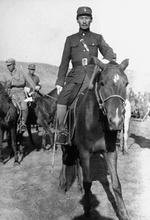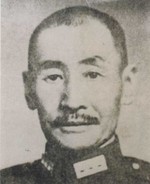Ma Zhanshan
| Surname | Ma |
| Given Name | Zhanshan |
| Born | 1885 |
| Died | 29 Nov 1950 |
| Country | China |
| Category | Military-Ground |
| Gender | Male |
Contributor: C. Peter Chen
ww2dbaseMa Zhanshan was born in Gongzhuling, Jilin Province, China to a poor family. In 1905, he joined the forces of the local warlord, Wu Junsheng, at Huaide County, Jilin. In 1908, he was promoted to Guard Monitor of the 4th Security Guard Battalion for his marksmanship and equestrian skills. In 1913, he became the the commanding officer of the 3rd Company, 3rd Regiment, 2nd Brigade of the Central Cavalry Army of the newly formed Republic of China. In 1920, he was promoted to the rank of colonel. Transferring to the Northeastern Army based in Manchuria in northeastern China, he served as the commander of the 5th Cavalry Brigade of the 17th Cavalry Division, and then served as the commander of the 3rd Infantry Brigade of the Heilongjiang Army. In 1928, he became the commanding officer of the Heilongjiang Provincial Cavalry. On 10 Oct 1931, a month after the Japanese staged the Mukden Incident and by now waging a campaign against northeastern China, Warlord Zhang Xueliang appointed Ma as the acting commander-in-chief of the Heilongjiang Province because Governor Wan Fulin was in Beijing. He arrived in the provincial capital Qiqihar on 19 Oct. After several engagements with the Japanese, his troops had suffered several hundred casualties, but on 15 Nov, he continued to reject all Japanese demands for surrender. On 17 Nov 1931, 3,500 Japanese troops under General Jiro Tamon launched an attack against Ma's 8,000 men, and drove Ma out of Qiqihar at the end of the namesake battle; although Ma's troops enjoyed a numerical advantage, he was over-gunned by the Japanese aircraft, light tanks, and artillery pieces. Despite his defeat, he rallied the population with his stubbornness. He fell back Baiquan and Hailun to the east, then fell back further up the Nonni River after repeated Japanese attacks, each time causing alarming casualties. In Dec 1931 or Jan 1932, he was offered a large sum of money by Japanese Colonel Kenji Doihara for his defection, which he accepted. He flew to Mukden in Jan 1932 and attended the meeting that founded the Japanese-sponsored nation of Manchukuo, but did not sign the declaration of independence, citing that he was feeling ill that day. He was named the War Minister of Manchukuo while also holding the position of the Governor of Heilongjiang Province. Using funds provided by the Japanese, he equipped a private army; part of the funding was given to the families of those serving under him so that they could be evacuated out of Manchukuo. On 1 Apr 1932, he led his troops out of Qiqihar, claiming that he was holding a tour of inspection. On 7 Apr, he announced the re-establishment of the Heilongjiang Provincial Government and its independence from Manchukuo. He led the newly formed 300,000-strong Northeast Anti-Japanese National Salvation Army, consisted of his troops at its core and supported by volunteers, in a new war of resistance against the Japanese. As before, however, he suffered heavy casualties due to the lack of heavy weapons. He joined forces with Su Bingwen's Heilungkiang National Salvation Army in Longmen County in Sep 1932, but the defeats continued, eventually forcing them to flee across the Russian border by Dec 1932.
ww2dbaseMa's return to China took them through Russia, Germany, and then Italy, arriving in Jun 1933. He met with Republic of China leader Chiang Kaishek, asking for troops for another campaign against the Japanese, but Chiang rejected his request. Ma thus moved to the city of Tianjin on the Chinese coast and remained there until Oct 1936 when Chiang finally called for his service. He was present in Xi'an during the Xi'an Incident in which Zhang Xueliang kidnapped Chiang Kaishek in an attempt to pause the Chinese civil war between the Nationalists and the Communists; Ma was among those who advised Zhang not to harm Chiang. Ma briefly held the position of the commanding officer of the Anti-Japanese Aid Suiyuan Cavalry Group Army, appointed by Zhang, before Chiang countermanded that assignment.
ww2dbaseAfter the start of the Second Sino-Japanese War in 1937, Ma served as the commanding officer of the Northeastern Advance Force based in Liaoning, Jilin, Heilongjiang, and Rehe. He established his headquarters in Datong, Shanxi Province. Over time, he found himself more aligned with the Chinese Communists, especially that he viewed Chiang's strategy in the war against the Japanese as too conservative. He visited the Chinese Communist leaders at Yan'an, Shaanxi Province and secretly accepted the position of the Chairman of the Provisional Government of Heilongjiang in Aug 1940 with the Communist Party. Despite this action, he remained a leader in the Nationalist military in the war against Japan.
ww2dbaseAfter the end of WW2, the Nationalist government appointed Ma the Northeast Deputy Security Commander based in Shenyang (restored Chinese Mandarin name of Mukden), but only six months later he retired from service, citing ill health, and moved to Beijing. In Jan 1949, he formally declared his defection to the Communist Party. He was invited by Mao Zedong to attend the Chinese People's Political Consultative Conference in Jun 1950, but he would not be able to attend due to a serious illness that would claim his life later in the same year.
ww2dbaseSource: Wikipedia.
Last Major Revision: Jul 2010
Photographs
 |  |
Ma Zhanshan Timeline
| 14 Feb 1932 | Chinese General Ma Zhanshan surrendered to the Japanese in Heilongjiang Province, China. |
| 1 Mar 1932 | Ma Zhanshan was made the Minister of War of the Japanese-sponsored puppet state of Manchukuo in northeastern China. |
| 7 Apr 1932 | Chinese General Ma Zhanshan declared the Heilungkiang Provincial Government in Japanese-occupied Manchuria in northeastern China. He would soon begin to organize what was to become the Northeast Anti-Japanese National Salvation Army. |
| 29 Nov 1950 | Zhanshan Ma passed away. |
Did you enjoy this article or find this article helpful? If so, please consider supporting us on Patreon. Even $1 per month will go a long way! Thank you. Share this article with your friends: Stay updated with WW2DB: |
» Battle of Qiqihar
» Battle of Harbin and Establishment of Manchukuo
» Xi'an Incident
- » 1,150 biographies
- » 337 events
- » 43,917 timeline entries
- » 1,241 ships
- » 350 aircraft models
- » 207 vehicle models
- » 374 weapon models
- » 123 historical documents
- » 260 facilities
- » 470 book reviews
- » 28,543 photos
- » 432 maps
Winston Churchill
Please consider supporting us on Patreon. Even $1 a month will go a long way. Thank you!
Or, please support us by purchasing some WW2DB merchandise at TeeSpring, Thank you!